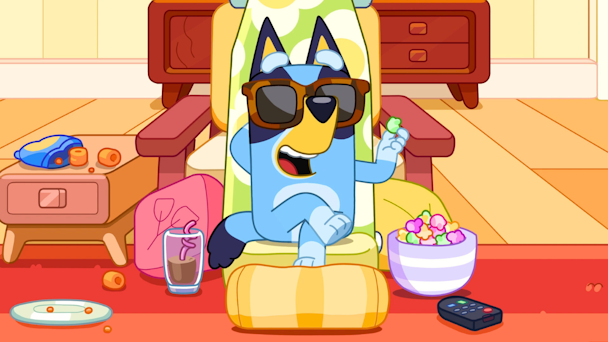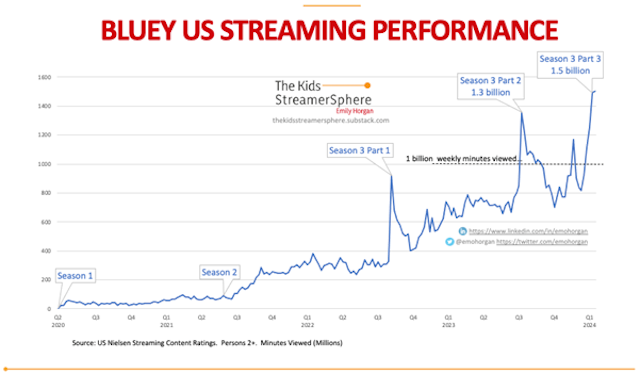What the rise of Bluey tells us about kids entertainment in 2024
Former ‘mouseketeer’ and consultant Emily Horgan takes us on an extensive journey through the rise of an IP that would make other brands blue with envy. Yes, it’s Bluey, and you either know it and love it... or you are about to.

/ ABC
When you think ‘Streaming Wars,’ you think of prestige ‘Originals’ like Stranger Things, The Mandalorian, The Crown, Bridgerton and Squid Game, but you aren’t getting the whole story. What if I told you that the second biggest show overall in US streaming last year was an animated Australian 2D preschool IP? Parents of little ones can already hear the melodica theme tune.
Bluey, the biggest thing in preschool, is bringing in the bucks, is beloved by parents, and this week was bestowed a trailer for a ‘super-sized’ episode that looks suspiciously like a ‘movie.’
How did Bluey come to dominate streaming?
It’s part strategy, part luck, underpinned by a truly wonderful show that’s worth watching, whatever your age. It is definitely a need-to-know for anyone with an interest in current brands. Fan-faring the under-sung genre of kids’ TV is something I like to do a lot on LinkedIn, so follow me if you fancy learning more.
Brand building for preschool IP has always been big business. Success brings multiyear revenue streams of billions, and the tail can be long (who says animal and finance puns don’t mix?). PAW Patrol is still going a decade later. Peppa Pig is now 18, officially of drinking age.
There used to be a pretty established way of launching preschool franchises like these. Develop a show with decent characters, storytelling and toyetic hooks. There’s a bonus if the team involved has a track record. Get the series commissioned. Two great places to strike deals of this nature were pay TV operations like Disney, Nickelodeon or Cartoon Network, which could bring your show to their matrix of channels globally, or free-to-air broadcasters (including PSBs like CBeebies), which could have your brand instantly in homes of a particular territory at scale. Once you know your platform, negotiations could start with master toy licensees; the Mattels and Hasbros of the world would need advance planning to get toy molding in operation, and a strategy could be hatched based on key market availability. From there, you market your socks off, build further distribution, and hope the franchise gods are kind and audiences connect with your IP.
It sounds easy, but of course it’s not.
From my former life as a mouseketeer, I can testify that even at the biggest family IP factory in the world, there are hits and misses. That being said, Peppa and PAW Patrol were born from a true primetime era of preschool TV IP. Dora the Explorer and Bob the Builder were the OG household names. Hey Duggee, Octonauts, Miraculous Ladybug and PJ Masks came from that period and still persist as ongoing concerns. All broadly followed the same playbook.
Streaming fundamentally disrupted this, something I’m cataloging in my newsletter, The Kids StreamerSphere.
YouTube - the game changer for kids’ TV
First came YouTube, where Peppa was pirated at scale. Be it a strategic decision or not, the brand arguably benefited from this radical availability. It had the perfect short duration and simple visual style for mobile-first consumption. Then came long-form SVOD services, led by Netflix.
As traditional media companies launched their own global offerings, Disney+, Max, Paramount Plus, Peacock, etc, streaming wars hit fever pitch, heightened beyond anyone’s expectation through the pandemic. Alongside this, the playbook of launching preschool IP was starting to evolve.
But with streaming for kids, YouTube is, and was, always the winner.
Recent research from Precise TV and Giraffe Insights shows that 83% of kids in the US have watched YouTube recently, compared with the next closest competitor, Netflix, at 34%. Given YouTube has always been free to access, with no age gate and available on any device with internet access, its place in the pecking order isn’t surprising. These days, and key for preschoolers, it’s gaining more prominence in the living room through CTVs.
YouTube is also a fertile engagement plain for IP cultivation. Companies like Pocket Watch and Moonbug Entertainment have made a business out of mining for kids' IP diamonds in the messy mire of creators. Owned by the latter, the biggest YouTube preschool IP is currently CoComelon, emerging from the nursery rhyme genre, which has solidified ubiquity on the platform. Engagement with CoComelon is so sticky that it has also dominated audiences, even after moving on to other streaming services like Netflix and BBC iPlayer. Other examples of this type of digital-first IP are brands like Ryan’s Toy Review and Baby Shark, both with shows produced by Nick Jr.
But don’t write off traditional TV formats yet
It is worth remembering that Bluey is a preschool IP originating from Australia. And Australian it truly is. Bluey is bringing her local accent and vernacular to preschoolers worldwide, just as Peppa did before her. The show has a remarkable balance of humor and heart, spawning fan podcasts, TikTok memes and regular think-pieces in The Guardian.
This new king of preschool IP was actually born of the ways of old as a straight commission from the Australian public service broadcaster ABC, which later boarded the streaming train through Disney+ as a third-party acquisition in 2019. However, the show was so special that Disney couldn’t resist nabbing rights for many of their linear channels, definitely in decline but still relevant.
Linear still has one edge over streaming, the undeniable discoverability real estate.
Where thumbnails and algorithms drive streaming, linear channels offer routine, guaranteed visibility, and direct content sampling as viewers channel hop (the origin point of current TikTok behavior?). Younger skewing traditional format TV series have struggled on streaming without these levers. Preschoolers binge-watch, oh yes, they do, but it’s in a completely different way to adult audiences. The neophobia is real, viewers need to sample content multiple times before they convert. There’s also a conveyor belt of eyeballs coming through, a good thing, you would think, but programming streaming for these factors has been tricky.
Streamers cede ground to YouTube.
Netflix launched a slew of original in-house preschool IP in the last few years, coming from bankable showrunners like Keith Chapman (Bob the Builder/PAW Patrol) and Chris Nee (Doc McStuffins/Vampirina). Most failed to find an audience and were canceled after one season in the Great Netflix Correction in 2022. It wasn’t alone either; Max and Paramount Plus discarded many animated shows to facilitate debt loading during the major mergers of that period.
In this evolution from one entertainment landscape to another, Bluey had the best of both, with streaming and linear pulling together. It’s majorly paying off, as I unpacked in more detail for a recent edition of my newsletter. The show was the second biggest overall in US streaming last year, per Nielsen, and has recently been clocking over 1.5bn weekly minutes viewed. That level of performance tends to be reserved for aforementioned “prestige” streaming titles or comfort TV viewing like Suits or Friends.

The brand is also truly multi-platform, in addition to Disney+ and Disney linear channels, the Bluey YouTube has built to more than 150m monthly views per Social Blade. As I mentioned, YouTube is the king of kids streaming. Building a successful kids’ brand without a robust presence on the platform is impossible. Add this to the Instagram, Facebook and TikTok accounts, which target parents and older fans. Yes, even “the students” have come for Bluey.
Ironically, the success of Bluey sits alongside one of the biggest crises the kid’s media industry has ever faced. It’s bubbling up globally. The old pay TV linear budgets of before have been decimated. Streamers dipped their toes in kids’ commissioning and were unsure of the water temperature. Currently, they are prioritizing IP that has a proven track record. Public service broadcasters are doing their best but are stretched more than ever. Even the opportunity offered by YouTube ad revenue is a fraction of what it once was. This was fully gazumped by the introduction of made for kids (MFK) content in YouTube’s own “correction” after they were hit with an FTC fine for Coppa violations.
However, one thing remains the same: in terms of success, preschool brands represent a huge opportunity. Bluey exemplifies this. It also fulfills the undeniable duty of care to provide our youngest audiences with content that offers a positive mental deposit. Bluey has proven that you can find a dog that does both. Here’s hoping the business of kids’ TV evolves to find a model that continues to support the success of great shows like this that both delight families and drive subscribers.
This ran as part of The Drum’s latest Focus Week, where we are focusing on the ever-evolving entertainment industry.

